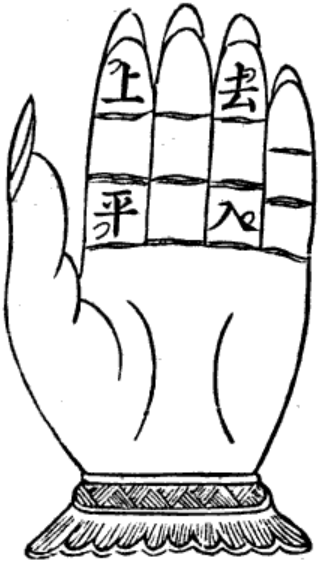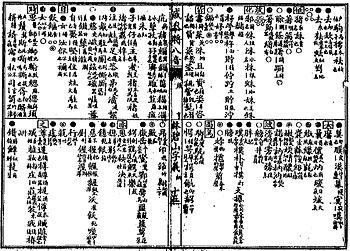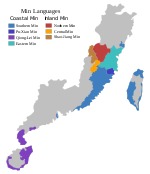
Middle Chinese or the Qieyun system (QYS) is the historical variety of Chinese recorded in the Qieyun, a rime dictionary first published in 601 and followed by several revised and expanded editions. The Swedish linguist Bernard Karlgren believed that the dictionary recorded a speech standard of the capital Chang'an of the Sui and Tang dynasties. However, based on the more recently recovered preface of the Qieyun, most scholars now believe that it records a compromise between northern and southern reading and poetic traditions from the late Northern and Southern dynasties period. This composite system contains important information for the reconstruction of the preceding system of Old Chinese phonology.
Fanqie is a method in traditional Chinese lexicography to indicate the pronunciation of a monosyllabic character by using two other characters, one with the same initial consonant as the desired syllable and one with the same rest of the syllable . The method was introduced in the 3rd century AD and used in dictionaries and commentaries on the classics until the early 20th century.

A rime dictionary, rhyme dictionary, or rime book is an ancient type of Chinese dictionary that collates characters by tone and rhyme, instead of by radical. The most important rime dictionary tradition began with the Qieyun (601), which codified correct pronunciations for reading the classics and writing poetry by combining the reading traditions of north and south China. This work became very popular during the Tang dynasty, and went through a series of revisions and expansions, of which the most famous is the Guangyun (1007–1008).
The Shanghainese language, also known as the Shanghai dialect, or Hu language, is a variety of Wu Chinese spoken in the central districts of the City of Shanghai and its surrounding areas. It is classified as part of the Sino-Tibetan language family. Shanghainese, like the rest of the Wu language group, is mutually unintelligible with other varieties of Chinese, such as Mandarin.

Eastern Min or Min Dong, is a branch of the Min group of Sinitic languages of China. The prestige form and most-cited representative form is the Fuzhou dialect, the speech of the capital of Fujian.
General Chinese is a diaphonemic orthography invented by Yuen Ren Chao to represent the pronunciations of all major varieties of Chinese simultaneously. It is "the most complete genuine Chinese diasystem yet published". It can also be used for the Korean, Japanese, and Vietnamese pronunciations of Chinese characters, and challenges the claim that Chinese characters are required for interdialectal communication in written Chinese.

The Fuzhou language, also Foochow, Hokchew, Hok-chiu, or Fuzhounese, is the prestige variety of the Eastern Min branch of Min Chinese spoken mainly in the Mindong region of Eastern Fujian Province. As it is mutually unintelligible to neighbouring varieties in the province, under a technical linguistic definition Fuzhou is a language and not a dialect. Thus, while Fuzhou may be commonly referred to as a 'dialect' by laypersons, this is colloquial usage and not recognised in academic linguistics. Like many other varieties of Chinese, the Fuzhou dialect is dominated by monosyllabic morphemes that carry lexical tones, and has a mainly analytic syntax. While the Eastern Min branch it belongs to is relatively closer to Southern Min or Hokkien than to other Sinitic branches such as Mandarin, Wu Chinese or Hakka, they are still not mutually intelligible.
Zhongyuan Yinyun, literally meaning "Rhymes of the central plain", is a rime book from the Yuan dynasty compiled by Zhou Deqing (周德清) in 1324. An important work for the study of historical Chinese phonology, it testifies many phonological changes from Middle Chinese to Old Mandarin, such as the reduction and disappearance of final stop consonants and the reorganization of the Middle Chinese tones. Though often termed a "rime dictionary", the work does not provide meanings for its entries.
A checked tone, commonly known by the Chinese calque entering tone, is one of the four syllable types in the phonology of Middle Chinese. Although usually translated as "tone", a checked tone is not a tone in the phonetic sense but rather a syllable that ends in a stop consonant or a glottal stop. Separating the checked tone allows -p, -t, and -k to be treated as allophones of -m, -n, and -ng, respectively, since they are in complementary distribution. Stops appear only in the checked tone, and nasals appear only in the other tones. Because of the origin of tone in Chinese, the number of tones found in such syllables is smaller than the number of tones in other syllables. In Chinese phonetics, they have traditionally been counted separately.

Foochow Romanized, also known as Bàng-uâ-cê or Hók-ciŭ-uâ Lò̤-mā-cê, is a Latin alphabet for the Fuzhou dialect of Eastern Min adopted in the middle of the 19th century by Western missionaries. It had varied at different times, and became standardized in the 1890s. Foochow Romanized was mainly used inside of church circles, and was taught in some mission schools in Fuzhou. However, unlike its counterpart Pe̍h-ōe-jī for Hokkien, even in its prime days Foochow Romanized was by no means universally understood by Christians.
Wenzhounese, also known as Oujiang, Tong Au or Au Nyü, is the language spoken in Wenzhou, the southern prefecture of Zhejiang, China. Nicknamed the "Devil's Language" for its complexity and difficulty, it is the most divergent division of Wu Chinese, with little to no mutual intelligibility with other Wu dialects or any other variety of Chinese. It features noticeable elements in common with Min Chinese, which is spoken to the south in Fujian. Oujiang is sometimes used as the broader term, and Wenzhou for Wenzhounese proper in a narrow sense.

Puxian, also known as Pu-Xian Chinese, Puxian Min, Xinghua, Henghwa or Hinghwa, is a Sinitic language that forms a branch of Min Chinese. Puxian is a transitional variety of Coastal Min which shares characteristics with both Eastern Min and Southern Min, although it is closer to the latter.

Fuzhou people, also known as, Foochowese, Hokchew, Hokchia, Hokchiu, Fuzhou Shiyi people (福州十邑人), Eastern Min or Mindong refer to Chinese who originate from the Fuzhou and Mindong regions and the Gutian and Pingnan counties of Fujian province and Matsu Islands in Taiwan. Fuzhou people are a part of the Min Chinese-speaking group that speaks Eastern Min or specifically Fuzhou dialect. There is also a significant overseas Fuzhou population, particularly distributed in Malaysia, Indonesia, Japan, United States, Singapore and the United Kingdom.

The four tones of Chinese poetry and dialectology are four traditional tone classes of Chinese words. They play an important role in Chinese poetry and in comparative studies of tonal development in the modern varieties of Chinese, both in traditional Chinese and in Western linguistics. They correspond to the phonology of Middle Chinese, and are named even or level, rising, departing or going, and entering or checked. They were reconstructed as mid, mid rising, high falling, and mid with a final stop consonant respectively. Due to historic splits and mergers, none of the modern varieties of Chinese have the exact four tones of Middle Chinese, but they are noted in rhyming dictionaries.
The Fuqing dialect, or Hokchia, is an Eastern Min dialect. It is spoken in the county-level city of Fuqing, China, situated within the prefecture-level city of Fuzhou. It is not completely mutually intelligible with the Fuzhou dialect.
The Shenglei 聲類, compiled by the Cao Wei dynasty lexicographer Li Deng 李登, was the first Chinese rime dictionary. Earlier dictionaries were organized either by semantic fields or by character radicals. The last copies of the Shenglei were lost around the 13th century, and it is known only from earlier descriptions and quotations, which say it was in 10 volumes and contained 11,520 Chinese character entries, categorized by linguistic tone in terms of the wǔshēng 五聲 "Five Tones " from Chinese musicology and wǔxíng 五行 "Five Phases/Elements" theory.
Shaxian dialect is a dialect of Central Min Chinese spoken in Sha County, Sanming in Western Fujian Province of China.

The Matsu dialect is the local dialect of Matsu Islands, Taiwan. Native speakers also call it Bàng-huâ (平話), meaning the language spoken in everyday life. It is recognised as one of the statutory languages for public transport announcements in Lienchiang County, Taiwan.

A Syllabic Dictionary of the Chinese Language: Arranged According to the Wu-Fang Yuen Yin, with the Pronunciation of the Characters as Heard in Peking, Canton, Amoy, and Shanghai or the Hàn-Yīng yùnfǔ 漢英韻府, compiled by the American sinologist and missionary Samuel Wells Williams in 1874, is a 1,150-page bilingual dictionary including 10,940 character headword entries, alphabetically collated under 522 syllables. Williams' dictionary includes, in addition to Mandarin, Chinese variants from Middle Chinese and four regional varieties of Chinese, according to the 17th-century Wufang yuanyin 五方元音 "Proto-sounds of Speech in All Directions".
In Chinese dialectology, Beijing Mandarin refers to a major branch of Mandarin Chinese recognized by the Language Atlas of China, encompassing a number of dialects spoken in areas of Beijing, Hebei, Inner Mongolia, Liaoning, and Tianjin, the most important of which is the Beijing dialect, which provides the phonological basis for Standard Chinese. Both Beijing Mandarin and its Beijing dialect are also called Beijingese.









